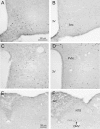Corticotropin-releasing factor-overexpressing mice exhibit reduced neuronal activation in the arcuate nucleus and food intake in response to fasting
- PMID: 18787020
- PMCID: PMC2630908
- DOI: 10.1210/en.2008-0723
Corticotropin-releasing factor-overexpressing mice exhibit reduced neuronal activation in the arcuate nucleus and food intake in response to fasting
Abstract
Corticotropin-releasing factor (CRF) overexpressing (OE) mice are a genetic model that exhibits features of chronic stress. We investigated whether the adaptive feeding response to a hypocaloric challenge induced by food deprivation is impaired under conditions of chronic CRF overproduction. Food intake response to a 16-h overnight fast and ip injection of gut hormones regulating food intake were compared in CRF-OE and wild type (WT) littermate mice along with brain Fos expression, circulating ghrelin levels, and gastric emptying of a nonnutrient meal. CRF-OE mice injected ip with saline showed a 47 and 44% reduction of 30-min and 4-h cumulative food intake response to an overnight fast, respectively, compared with WT. However, the 30-min food intake decrease induced by ip cholecystokinin (3 microg/kg) and increase by ghrelin (300 microg/kg) were similar in CRF-OE and WT mice. Overnight fasting increased the plasma total ghrelin to similar levels in CRF-OE and WT mice, although CRF-OE mice had a 2-fold reduction of nonfasting ghrelin levels. The number of Fos-immunoreactive cells induced by fasting in the arcuate nucleus was reduced by 5.9-fold in CRF-OE compared with WT mice whereas no significant changes were observed in other hypothalamic nuclei. In contrast, fasted CRF-OE mice displayed a 5.6-fold increase in Fos-immunoreactive cell number in the dorsal motor nucleus of the vagus nerve and a 34% increase in 20-min gastric emptying. These findings indicate that sustained overproduction of hypothalamic CRF in mice interferes with fasting-induced activation of arcuate nucleus neurons and the related hyperphagic response.
Figures





Similar articles
-
Corticotropin-releasing factor overexpression in mice abrogates sex differences in body weight, visceral fat, and food intake response to a fast and alters levels of feeding regulatory hormones.Biol Sex Differ. 2017 Jan 13;8:2. doi: 10.1186/s13293-016-0122-6. eCollection 2017. Biol Sex Differ. 2017. PMID: 28101317 Free PMC article.
-
Des-acyl ghrelin acts by CRF type 2 receptors to disrupt fasted stomach motility in conscious rats.Gastroenterology. 2005 Jul;129(1):8-25. doi: 10.1053/j.gastro.2005.04.015. Gastroenterology. 2005. PMID: 16012930
-
Intracerebroventricular urocortin 3 counteracts central acyl ghrelin-induced hyperphagic and gastroprokinetic effects via CRF receptor 2 in rats.Drug Des Devel Ther. 2016 Oct 3;10:3281-3290. doi: 10.2147/DDDT.S113195. eCollection 2016. Drug Des Devel Ther. 2016. PMID: 27757017 Free PMC article.
-
Peripheral urocortin inhibits gastric emptying and food intake in mice: differential role of CRF receptor 2.Am J Physiol Regul Integr Comp Physiol. 2001 Nov;281(5):R1401-10. doi: 10.1152/ajpregu.2001.281.5.R1401. Am J Physiol Regul Integr Comp Physiol. 2001. PMID: 11641109
-
Desacyl ghrelin inhibits the orexigenic effect of peripherally injected ghrelin in rats.Peptides. 2008 Dec;29(12):2159-68. doi: 10.1016/j.peptides.2008.09.014. Epub 2008 Sep 30. Peptides. 2008. PMID: 18938204 Free PMC article.
Cited by
-
Localization of nesfatin-1 neurons in the mouse brain and functional implication.Brain Res. 2011 Jun 17;1396:20-34. doi: 10.1016/j.brainres.2011.04.031. Epub 2011 Apr 22. Brain Res. 2011. PMID: 21555116 Free PMC article.
-
Increased ghrelin sensitivity and calorie consumption in subordinate monkeys is affected by short-term astressin B administration.Endocrine. 2010 Oct;38(2):227-34. doi: 10.1007/s12020-010-9378-5. Epub 2010 Jul 17. Endocrine. 2010. PMID: 20981508 Free PMC article.
-
Assessing behavioural effects of chronic HPA axis activation using conditional CRH-overexpressing mice.Cell Mol Neurobiol. 2012 Jul;32(5):815-28. doi: 10.1007/s10571-011-9784-0. Epub 2011 Dec 25. Cell Mol Neurobiol. 2012. PMID: 22198557 Free PMC article.
-
Restraint stress activates nesfatin-1-immunoreactive brain nuclei in rats.Brain Res. 2009 Dec 1;1300:114-24. doi: 10.1016/j.brainres.2009.08.082. Epub 2009 Sep 3. Brain Res. 2009. PMID: 19733157 Free PMC article.
-
CRF receptor antagonist astressin-B reverses and prevents alopecia in CRF over-expressing mice.PLoS One. 2011 Feb 16;6(2):e16377. doi: 10.1371/journal.pone.0016377. PLoS One. 2011. PMID: 21359208 Free PMC article.
References
-
- Bale TL, Vale WW 2004 CRF and CRF receptors: role in stress responsivity and other behaviors. Annu Rev Pharmacol Toxicol 44:525–557 - PubMed
-
- Heinrichs SC, Koob GF 2004 Corticotropin-releasing factor in brain: a role in activation, arousal, and affect regulation. J Pharmacol Exp Ther 311:427–440 - PubMed
-
- Zorrilla EP, Taché Y, Koob GF 2003 Nibbling at CRF receptor control of feeding and gastrocolonic motility. Trends Pharmacol Sci 24:421–427 - PubMed
-
- Richard D, Lin Q, Timofeeva E 2002 The corticotropin-releasing factor family of peptides and CRF receptors: their roles in the regulation of energy balance. Eur J Pharmacol 440:189–197 - PubMed
Publication types
MeSH terms
Substances
Grants and funding
LinkOut - more resources
Full Text Sources
Molecular Biology Databases

